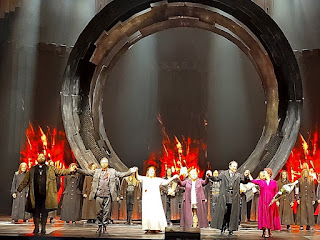Finally, after numerous postponements, the production of
Ooppera Skaala and Opera Box of ”Akhnaten” by Philip Glass was shown to the
audience in the Alexander Theatre during the Helsinki Contemporary Opera
Festival. I had already worried that due to other commitments it would never be
shown and that would have been a true loss.
The opera tells the story of the pharaoh Akhnaten in ancient
Egypt. In the beginning pharaoh Amenhotep III has died and his son inherits the
throne. The son abandons the religion of his father, founds a new monotheistic
religion and starts to call himself Akhnaten. He marries Nefertiti and they get
four daughters together. The supporters of the old religion start a rebel and
kill the whole family except Nefertiti and the mother of Akhnaten. The throne is inherited by Tutankhamon. In
the end, the archaeologists dig in Egypt.
Akhnaten is a
brilliant opera. Ville Saukkonen’s direction was superb, Janne Lehmusvuo’s
stage design and video projections were stunning and Kalle Paasonen’s light
design finalized the perfection. Also, the dancers and the actor Mika Nikander
in the role of Horus formed a perfect combination with the singers and the
musicians.
Glass’s music was almost hypnotic and Timothy Sexton’s
arrangement of the music to a small orchestra of keyboard and percussion instruments
was perfect (yes, I know I am repeating the word “perfect” a lot). The music
based a lot on repetition, but it was not boring, but rather energizing.
Contrary to many other operas, this one did not have any
subtitles, even though it was mostly sung in some other language than Finnish
(languages of ancient Egypt) and often the singer just sung some vowel. But the
absence of subtitles did not disturb at all, because the music itself was so
great. The role of Akhnaten was sung by Hungarian countertenor Zoltan Darago and
he was brilliant. His wife Nefertiti was mezzosoprano Essi Luttinen. The duet
of counter tenor and mezzosoprano was absolutely fabulous! Additionally, I have
to mention Ville Salonen, who sang the role of the high priest of Amon. His
voice did break a few times in the highest notes, but he acted magnificently the
role of the proud high priest. Superb job!
This opera and this direction I can with all my heart
recommend to everybody if it ever will re-enter the stage. Fantastic production!





































